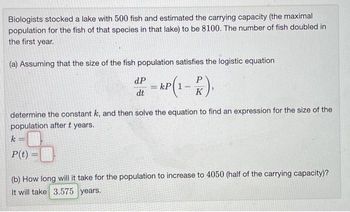
Advanced Engineering Mathematics
10th Edition
ISBN: 9780470458365
Author: Erwin Kreyszig
Publisher: Wiley, John & Sons, Incorporated
expand_more
expand_more
format_list_bulleted
Question

Transcribed Image Text:Biologists stocked a lake with 500 fish and estimated the carrying capacity (the maximal
population for the fish of that species in that lake) to be 8100. The number of fish doubled in
the first year.
(a) Assuming that the size of the fish population satisfies the logistic equation
dP - kp(1-2).
=
dt
determine the constant k, and then solve the equation to find an expression for the size of the
population after t years.
k -
P(t) =
(b) How long will it take for the population to increase to 4050 (half of the carrying capacity)?
It will take 3.575 years.
Expert Solution
This question has been solved!
Explore an expertly crafted, step-by-step solution for a thorough understanding of key concepts.
This is a popular solution
Trending nowThis is a popular solution!
Step by stepSolved in 3 steps

Knowledge Booster
Similar questions
- Assume 100 snails originally have the virus and that in early stages the number of snails infected is increasing approximately exponentially, with a continuous growth rate of 0.02. Assume further that in the long run, they estimate approximately 5300 snails will be infected. The number of snails infected after t hours after infection began is modeled by a logistic function: P=L1+Ce−kt What is the value of t when the rate at which snails are becoming infected peaks? Select the closest value.arrow_forwardA colony of 120 wood frogs was introduced to a pond with a carrying capacity of C=300. The population grows according to the logistic growth model, with a growth parameter is r = 1.5. The logistic growth formula is: pN+1 = rpN(1-pN) a) Find the initial p-value: p0 = Answer b) Find the first p-value: p1 = Answer c) Find the second p-value: p2 = Answerarrow_forwardA study of Maryland's portion of Chesapeake Bay found the following information about stocks of market-sized oysters.† In 1994, the stocks were 218 million. (This is the number you will use for the initial population N(0).) The carrying capacity is 5089 million oysters. The intrinsic exponential growth rate is 0.274 per year. (a) Find a logistic model N(t) for the number, in millions, of market-sized oysters. Take t to be the time in years since 1994. (Rround all regression parameters to three decimal places.) N(t) = (b) Plot the graph of the model you found in part (a) over the first 20 years. (c) How many market-sized oysters does your model predict for 2007? Round your answer, in millions, to the nearest whole number. million oysters (d) The actual number of market-sized oysters was found to be 82 million. Use the Internet to find possible explanations for the reduced levels of oysters in Chesapeake Bay.arrow_forward
- Biologists stocked a lake with 300 fish and estimated the carrying capacity (the maximal population for the fish of that species in that lake) to be 5000. The number of fish tripled in the first year. (a) Assuming that the size of the fish population satisfies the logistic equation dP = kp (1-P). (1-²), kP dt determine the constant k, and then solve the equation to find an expression for the size of the population after t years. k= P(t)= (b) How long will it take for the population to increase to 2500 (half of the carrying capacity)? It will take years.arrow_forwardIn terms of the model parameters, state the null hypothesis that, after controlling for sales and roe, ros has no effect on CEO salary. State the alternative that better stock market performance increases a CEO’s salary.arrow_forwardA nation's population (to the nearest million) was 281 million in 2000 and 311 in 2010. It is projected that the population in 2050 will be 439 million. To construct a logistic model, both the growth rate and the carrying capacity must be estimated. There are several ways to estimate these parameters. Use parts (a) through (f) to use one approach. a. Assume that t = 0 corresponds to 2000 and that the population growth is exponential for the first ten years; that is, between 2000 and 2010, the population is given by P(t) = P(0) e". Estimate the growth rate r using this assumption. = (Round to five decimal places as needed.) b. Write the solution of the logistic equation with the value of r found in part (a). Write any populations in the logistic equation in millions of people. P(t) = Use the projected value P(50) = 439 million to find a value of the carrying capacity K. K= (Type an integer or decimal rounded to the nearest hundredth as needed.) c. According to the logistic model…arrow_forward
arrow_back_ios
arrow_forward_ios
Recommended textbooks for you
 Advanced Engineering MathematicsAdvanced MathISBN:9780470458365Author:Erwin KreyszigPublisher:Wiley, John & Sons, Incorporated
Advanced Engineering MathematicsAdvanced MathISBN:9780470458365Author:Erwin KreyszigPublisher:Wiley, John & Sons, Incorporated Numerical Methods for EngineersAdvanced MathISBN:9780073397924Author:Steven C. Chapra Dr., Raymond P. CanalePublisher:McGraw-Hill Education
Numerical Methods for EngineersAdvanced MathISBN:9780073397924Author:Steven C. Chapra Dr., Raymond P. CanalePublisher:McGraw-Hill Education Introductory Mathematics for Engineering Applicat...Advanced MathISBN:9781118141809Author:Nathan KlingbeilPublisher:WILEY
Introductory Mathematics for Engineering Applicat...Advanced MathISBN:9781118141809Author:Nathan KlingbeilPublisher:WILEY Mathematics For Machine TechnologyAdvanced MathISBN:9781337798310Author:Peterson, John.Publisher:Cengage Learning,
Mathematics For Machine TechnologyAdvanced MathISBN:9781337798310Author:Peterson, John.Publisher:Cengage Learning,


Advanced Engineering Mathematics
Advanced Math
ISBN:9780470458365
Author:Erwin Kreyszig
Publisher:Wiley, John & Sons, Incorporated

Numerical Methods for Engineers
Advanced Math
ISBN:9780073397924
Author:Steven C. Chapra Dr., Raymond P. Canale
Publisher:McGraw-Hill Education

Introductory Mathematics for Engineering Applicat...
Advanced Math
ISBN:9781118141809
Author:Nathan Klingbeil
Publisher:WILEY

Mathematics For Machine Technology
Advanced Math
ISBN:9781337798310
Author:Peterson, John.
Publisher:Cengage Learning,

